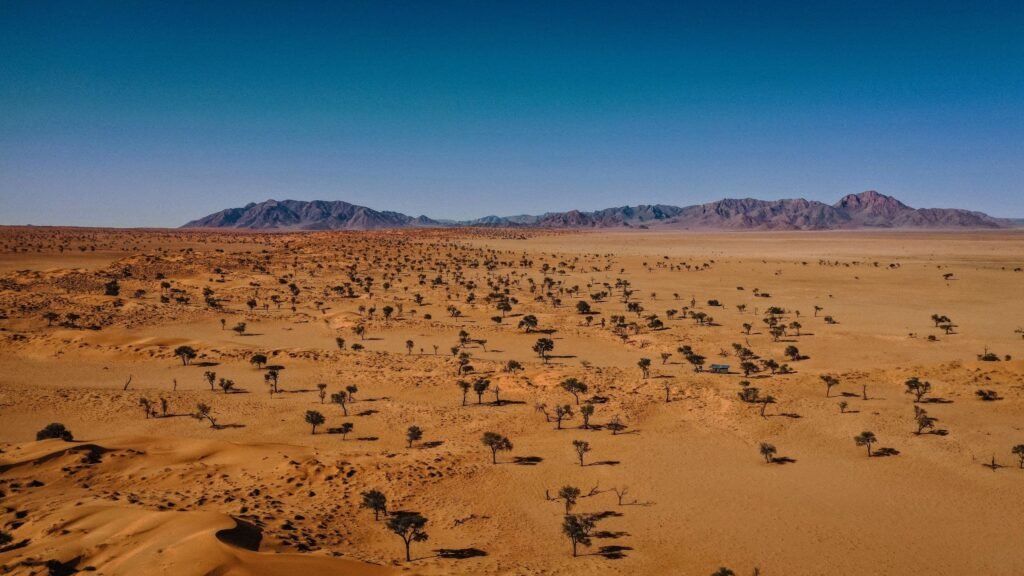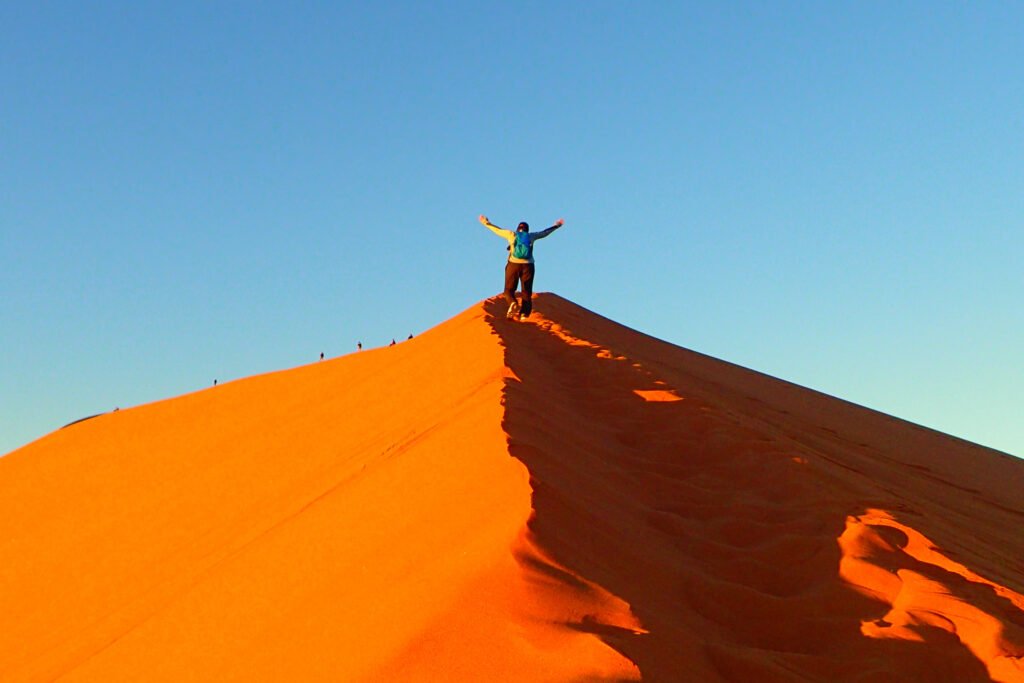The Namib Desert is touted as being the oldest desert in the world. It is one of the most underrated tourist destinations in Africa. The iconic sands of the Namib have a surprising amount of plants and other species despite being arid. One of the most iconic sites to see at Namib are Sossusvlei and Deadvlei which are best explored from above via a hot air balloon.
Lying between a high inland plateau and the Atlantic Ocean, the Namib Desert extends along the coast of Namibia, merging with the Kaokoveld Desert into Angola in the north and south with the Karoo Desert in South Africa.
Towering rusty red sand dunes, bleached white clay pans with dead camel thorn trees, and mysterious fairy circles. These are some of the things which make the landscapes of Sossusvlei so spectacular and a must-see for all travellers to Namibia.

Throughout this vast landscape, a number of animals and plants have adapted to life here, including the mountain zebra (Equus zebra), gemsbok (Oryx Gazella), short-eared elephant shrew (Macroscelides proboscideus), Grant’s golden mole (Eremitalpa granti), Karoo bustard (Eupodotis vigorsii) and Peringuey’s adder (Bitis peringueyi).
Although large parts of this desert region are protected, it still faces threats from unsustainable land practices, mining, and illegal plant harvesting.
The Namib Desert is of course the best place to experience Namibia desert tours. But as you may have guessed: The Namib is not exactly small. One of the most popular areas is the Namib-Naukluft Park and specifically the Sossusvlei region with its iconic Deadvlei, Big Daddy dune, and Dune 45 as well as the Sesriem Canyon. The desert around the coastal town of Swakopmund is known as Dorob National Park and is famous for its adventure activities and entertaining educational tours.
The Namib Desert is in one of the largest conservation areas in Africa (the Namib-Naukluft National Park) and it is here where you will find Sossusvlei, one of Namibia’s best-known and spectacular natural sites
Sossusvlei is spectacular throughout the year. No matter when you visit, the landscapes will leave you in awe. Temperatures are warm all year round, although admittingly slightly warmer in summer, and in true desert fashion, it is very dry. However, during the summer months, the odd rain shower can come down over the surrounding area, and in very special years, it may even rain in the Sossusvlei region itself. During this time, you might be able to witness the very rare sight of the normally dry pans filled with water and patches of green grass on the dunes.
Directly after entering the park, you will notice a road which leads approximately 4.5 kilometres to the Sesriem Canyon. The canyon was shaped by the Tsauchab River over the course of millions of years, and it was this river flowing through the canyon that once gave life to the now dried-out pans of the Deadvlei and Sossusvlei. You can descend into the Sesriem Canyon to take a walk along its usually dry riverbed and explore its interesting rock formations. It is only during times of heavy rain that the canyon holds water in some places.

Further down the road and deeper into the park, you enter a world of towering sand dunes, some of which are thought to be amongst the largest in the world.
A particularly notable dune is the beautiful Dune 45. Named rather unimaginatively after its distance from the entrance gate (45 kilometres), this 85 metres high dune is one of the most popular dunes for travellers to climb as the view of the surrounding desert landscape presented from the top is awe-inspiring. Its remarkable shape and accessibility make it probably the most photographed dune in the world.
After a further 15 kilometres, the comfortable tarred road you are on ends and the 5-kilometre 4×4 section taking you to the Deadvlei and Sossusvlei begins. There are parking facilities here so that visitors can park their vehicles and travel the last section by shuttle. Travellers who are more experienced when it comes to 4×4 driving can drive the upcoming off-road section themselves, provided they have the correct vehicle. Both the Deadvlei and Sossusvlei are clay pans that, hundreds of years ago, were supplied with water by the Tsauchab River. However, the climate changed, and the sand dunes encroached on the pans, blocking the river from reaching the area and causing the pans to dry out. Although the Sossusvlei pan is more famous by name, it is the Deadvlei that is most commonly visited and photographed. Camel thorn trees grew here when there was water, but once the pan dried up these trees began to die.





